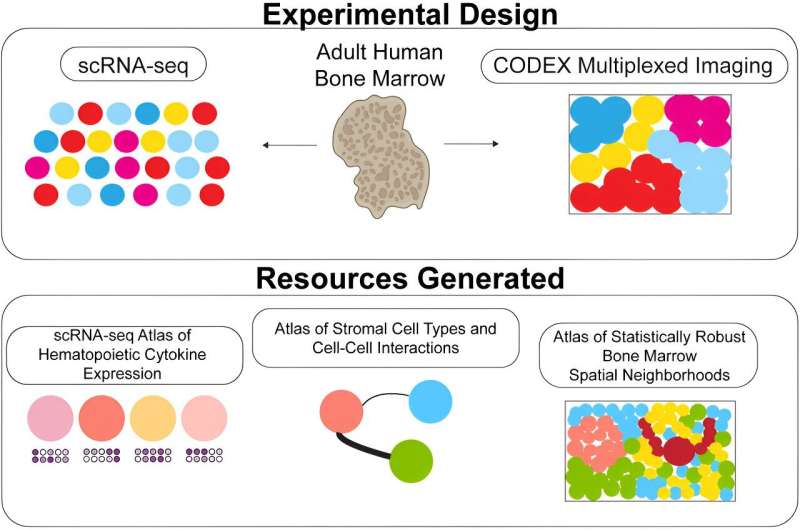This article has been reviewed according to Science X's editorial process and policies. Editors have highlighted the following attributes while ensuring the content's credibility:
fact-checked
peer-reviewed publication
trusted source
proofread
Biomolecular atlas for bone marrow offers unprecedented window into blood production

Researchers at Children's Hospital of Philadelphia (CHOP) and the Perelman School of Medicine at the University of Pennsylvania have revealed a powerful new bone marrow atlas that will offer the public a first-of-its-kind visual passport into the spectrum of healthy and diseased blood production. The findings are published in the journal Cell.
"For the first time, we will have a comprehensive framework to view the full gene expression and spatial organization of bone marrow cells," said senior study author Kai Tan, Ph.D., a professor in the Department of Pediatrics and an investigator in CHOP's Center for Childhood Cancer Research. "Although our paper is foundational, we envision the atlas will be used to develop new diagnostic tests, identify new CAR-T or other therapeutic targets, and discover spatial biomarkers of disease."
Although spearheaded by CHOP and Penn, the study is also part of the broader Human BioMolecular Atlas Program (HuBMAP). The HuBMAP consortium is comprised of 42 diverse research teams at universities across 14 states and four countries. Researchers are collaborating to create the next generation of molecular analysis technologies and computational tools, which will allow researchers to create foundational tissue maps and construct an atlas of the function and relationships among cells in the human body.
"Studies of this magnitude are only possible with monumental team efforts," said Shovik Bandyopadhyay, Ph.D., lead author of the study and a physician-scientist in-training in Tan's lab. "With the collaboration of multiple institutions and scientific consortia, we were able to gain fundamental insight into the microscopic building blocks of the human body."
Scientists have long theorized that while most bone marrow consists of blood cells, a small percentage of non-blood cells may play an important role in pediatric and adult bone marrow diseases such as leukemia, myeloproliferative disorders, or bone marrow failure syndromes. However, prior to this study, research was challenging due to technical issues arising from the rarity and fragility of these cells.
This paper is the first to overcome those limitations and comprehensively profile adult human bone marrow using single-cell RNA sequencing. The technique captures the full gene expression profiles of tens of thousands of individual cells, uncovering the complete mix of cell types that make up an organ.
In the study, researchers focused on bone marrow that regulates important processes in blood cell development and immunity. They captured at least nine subsets of non-hematopoietic cells, including stromal cells, bone cells, and endothelial (blood vessel) cells—at least three of which have not been previously reported and that produced critical supportive factors. Researchers were able to create an encyclopedia of which of these rare non-blood cells produce factors known to be important in human blood production, which will help researchers better understand which cellular communication to focus future studies on.
Their findings underscore the increasingly pivotal role technology plays in today's biomolecular research. The authors created the estimated 800,000 cell spatial bone marrow atlas to correspond with a transcriptional atlas by leveraging a sophisticated new technique called CODEX along with machine learning. This approach, along with painstaking manual annotation of thousands of cells and structures, led them to discern that healthy bone marrow has very distinct spatial organization, and fat cells are more closely associated with blood-producing cells than previously understood.
"We are just beginning to scratch the surface of what's possible," said Tan. "Future research can build on our work, expediting bone marrow studies with the hope that one day these digital pathways will lead to health care breakthroughs in acute leukemia and other bone marrow disorders."
Ling Qin, Ph.D., the other senior author for this study and a professor of Orthopedic Surgery in the Perelman School of Medicine, agreed and said she also sees the research yielding lasting effects.
"When applied to leukemia patient samples, these techniques identify the expansion of mesenchymal cells, a type of rare non-blood cell, at the cancer cell site in the bone marrow," said Qin. "This reveals a potential new direction for future disease treatment."
More information: Shovik Bandyopadhyay et al, Mapping the cellular biogeography of human bone marrow niches using single-cell transcriptomics and proteomic imaging, Cell (2024). DOI: 10.1016/j.cell.2024.04.013

















